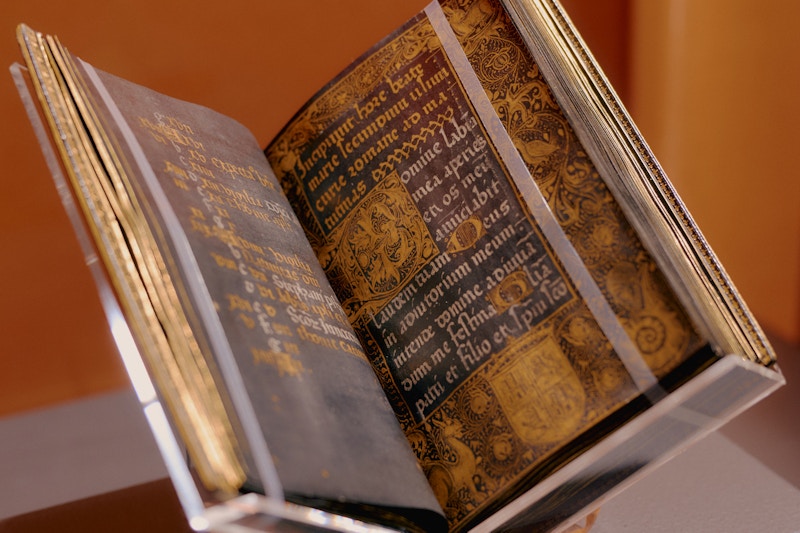
Pietro Francavilla, Venus with a Nymph and Satyr, 1600. Marble. 257.8 x 123.2 x 91.4 cm (101.5 x 48.5 x 36 in.). The William Arnold Healy Fund. Courtesy of the Wadsworth Atheneum Museum of Art.
Discover the Two Restoration Projects Receiving Support from the TEFAF Museum Restoration Fund This Year
In 2024, the fund will support the restoration of one of the finest Mannerist sculptures by Pietro Francavilla at the Wadsworth Atheneum Museum of Art and of a rare large-scale painting by Ludovico Mazzolino from the collection of the National Gallery of Ireland
- By Alina Arcari
- Museum Restoration Fund
The TEFAF Museum Restoration Fund (TMRF) was established in 2012 with the purpose to support and promote the professional restoration and related scholarly research of significant museum artworks. The commitment to championing art in all its forms is reflected in the global grant application process, welcoming submissions from museums worldwide and open to artworks from any period. Each year, the fund allocates a maximum of €50,000 to selected projects, a process overseen by a committee of independent experts.
In 2024, the TMRF has been awarded to the Wadsworth Atheneum Museum of Art and the National Gallery of Ireland to restore two important works from their collections: Venus with a Nymph and Satyr (1600) by the Franco-Flemish sculptor Pietro Francavilla and Italian Renaissance artist Ludovico Mazzolino’s The Crossing of the Red Sea (1521), respectively.
Wadsworth Atheneum Museum of Art
The Wadsworth Atheneum Museum of Art, founded in 1842, is the oldest continuously operating public art museum in the United States. It houses an expansive collection of nearly 50,000 artworks spanning 5,000 years, showcasing European art from antiquity to Modernism and American art from the 1600s to the present. With works by Caravaggio, Frederic Church, Georgia O’Keeffe, Salvador Dalí, Kara Walker, among many others, the institution presents exhibitions which delve into every era of art history.
With the support of the TMRF, the museum will restore Venus with a Nymph and Satyr by Pietro Francavilla (1548–1615), the most important example of Mannerist art in the museum’s collection. The sculpture was acquired in 1933 to serve as a dynamic counterpoint to the Modernist interior in the then new Avery Memorial building. Matthew Hargraves, director of the Wadsworth Atheneum, emphasizes how the sculpture exemplifies the symbiotic relationship between the art of the past and present: “Francavilla’s Venus continues to be emblematic of the Wadsworth Atheneum’s ability and desire to embrace the finest art both old and new.” Following his education in Paris and Innsbruck, Francavilla went on to become the principal assistant to the preeminent Mannerist sculptor Giambologna in Florence.

Pietro Francavilla, Venus with a Nymph and Satyr, 1600. Marble. 257.8 x 123.2 x 91.4 cm (101.5 x 48.5 x 36 in.). The William Arnold Healy Fund. Courtesy of the Wadsworth Atheneum Museum of Art.
Francavilla additionally took on personal
commissions—the Venus being part of his first
major commission by Abbot Antonio Bracci.
The sculpture is one of a series of 13 marbles
the patron acquired for his garden at Villa
Zanobi Bracci in Rovezzano on the outskirts
of Florence. Francavilla’s style echoed that
of Giambologna, showcasing his concern
with the representation of movement and
anatomy. The elongated neck of Venus and
the subtle, twisted compositions are features
that Francavilla had explored through his
engagement with Giambologna’s sculptures.
By 1580, 12 allegorical figures had been delivered,
leaving the Venus to be completed in 1600,
marking it as one of the most significant multi-
figural groups made in marble in Florence
in the wake of Giambologna and before the
Baroque revolution of Gian Lorenzo Bernini.
“The ultimate goal is to restore the visual coherence of the marble and reanimate its dull and lifeless surface,” shares Hargraves. The sculpture has undergone several restoration processes in the past, after having experienced long travels, vandalism, and even being buried in the ground twice. In the mid-18th century, Frederick, Prince of Wales, acquired the full series for Windsor Castle. The Venus was later discovered buried in the grounds near Croydon and believed to have been deposited there during the transportation to its new home. Once found, the head of the satyr was broken off, leading to a comprehensive restoration by sculptor Thomas Thornycroft. Later, when installed on a pedestal in 1934, the underside of the marble was filled with plaster, slate, and charred wood; a vulnerable solution that will be replaced through a more sound and reversible technique in the forthcoming restoration. To allow for this, the entire sculpture will be lifted from its pedestal to have the surface cleaned and to reveal the richness of the marble with its subtle gray veining that currently is obscured. Visually distracting repairs from the 1850s or later will be toned so that the marble coheres visually, while maintaining Thornycroft’s sensitive and skillfully executed restorations.
The work has been the centerpiece of the courtyard in the Wadsworth Atheneum’s Avery Memorial building for over 90 years and the restoration will allow for the sculpture to be back in working order as a fountain sculpture. “This will enable Venus with a Nymph and Satyr to be properly appreciated as one of the finest Italian Mannerist sculptures in the United States,” says Hargraves.
National Gallery of Ireland
Since the opening of the National Gallery of Ireland in 1864, the institution has grown exponentially, building a significant collection centered on the 125 paintings which comprise the museum’s founding display. Today, the museum houses more than 16,000 works of art, constituting a survey of the history and development of European art. Represented in the museum are masterworks by some of art history’s most prolific names, including Caravaggio, Gainsborough, Goya, Picasso, Poussin, Rembrandt, Vermeer, and Velázquez.

Ludovico Mazzolino, The Crossing of the Red Sea, 1521. Oil on wood panel. 125 x 157 cm (49.2 x 61.8 in.). Courtesy of the National Gallery of Ireland. Licensed under CC BY 4.0.
As one of the TMRF recipients, the National Gallery of Ireland will research and conserve The Crossing of the Red Sea by Italian Renaissance artist Ludovico Mazzolino (c. 1480–1528). Regarded as a prominent painter in 16th-century Italy, Mazzolino worked for the Este court in Ferrara and later in the city of Bologna. While the artist typically worked on a modest scale, specializing in small devotional paintings, he later began to experiment with larger and more ambitious compositions, exemplified by The Crossing of the Red Sea. Recognized as an important and rare large-scale work in the artist’s œvre, this painting has been with the museum since 1914 and represents a significant precedent in the museum’s strong 17th-century Northern Italian collection. The Crossing of the Red Sea demonstrates Mazzolino’s ability to assimilate different artistic styles, both local and from beyond the Alps. The scene, including 150 small figures, presents an incredibly complex composition, illustrating the artist’s experimental spirit. Mazzolino abandoned the traditional rules of perspective and captured the chaotic scene from above, rendering each figure in exceptional detail.
The painting’s unstable condition has resulted in areas of the ground’s layers to lift and detach from the support. While the top layer of paint is generally in good condition, issues inherent to the use of wood panel as support have created an extensive network of fine cracks. “The ground layer appears to be very porous and lacking in binding materials, which may be partially responsible for the delamination of paint from the panel, and the presence of very brittle raised areas throughout the composition,” says Simone Mancini, head of conservation at the National Gallery of Ireland. Since the 1970s, the painting has not undergone any conservation treatments and, in light of urgent need, the museum plans to blend non-invasive and micro-invasive techniques, ensuring careful preservation of the panel while providing valuable insights into its pigments, binding agents, and varnishes, as well as potential options for addressing the extensive surface flaking.
The fragile condition of the panel has made it impossible to transport or display the work safely for decades. With this conservation project, the museum’s goal is to be able to present the painting in its collection once again and reveal the work’s striking, complex, and narrative-rich details for the public. Beyond restoring the stability of Mazzolino’s important work, curator Aoife Brady shares that the museum’s “hope is that the technical and art historical research and conservation treatments carried out during the course of the project will contribute to a broader understanding and appreciation of Mazzolino’s artistic techniques in 16th-century Italy.”


